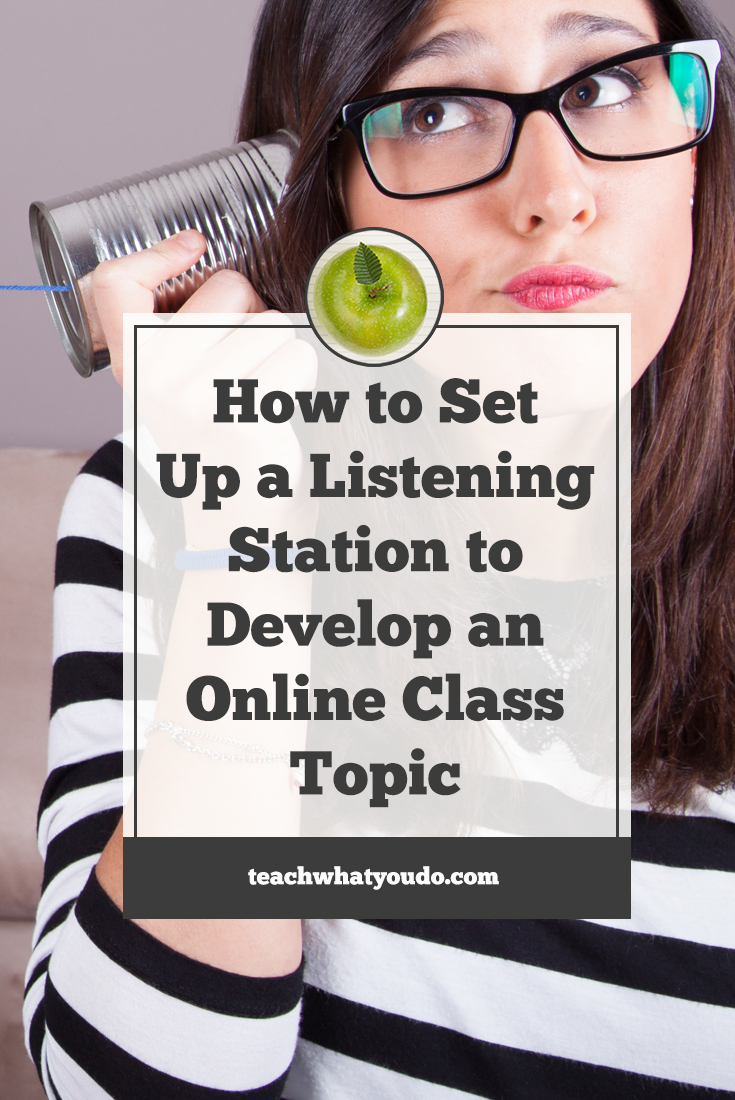 The most important thing to get right before you begin creating an online class is the topic. The best way to get this topic right is to find your people, understand what they need, and teach to that goal or transformation.
The most important thing to get right before you begin creating an online class is the topic. The best way to get this topic right is to find your people, understand what they need, and teach to that goal or transformation.
Who Do They Want to Be?
The successful e-Course will address a pressing need, problem or aspiration your audience faces. You'll teach what's needed in order for your student to become someone who no longer has the problem, to become someone who is transformed.
And, so, the starting place for creating an e-Course is defining your audience's pressing problem or aspiration. And that means one of the first things you need to do is to discover and refine your understanding of what your audience wants and what frustrates them.

Find Your Tribe's Online Water Cooler
One way to do this is with a direct survey of your people. Another way is to find your people where they convene. Go to the water cooler, and find out what their problems are, what the questions are that they ask again and again, what they aspire to, what frustrates them.

Step 1. Initial community listening
1. Identify at least six communities that you can visit regularly for the next 3 weeks. You might already be visiting some of them. These could be online forums, Facebook Groups or Linked-In Groups or another type of community.
2. Add the community names to the spreadsheet that I've set up for you on google docs. You'll need to save it as a copy for yourself. Click here for the worksheet.

3. Determine a weekly schedule for checking in on these communities – shoot to visit each one at least 3 times per week.
4. As you visit watch to see:
- What topics come up over and over — and are there questions that are really a variation on a single pressing question?
- What topics get the most views and the most “voices” or replies.
- What terms or “keywords” describe those frequent topics?
- Who are the advisors this community references?
- What are the products this community uses, talks about, asks about, shares tips about, looks for help with?
- Who are your stand-out peers in this community?
5. Note these keywords, peers, advisors, and products on the spreadsheet. This is valuable for figuring out the exact course you can teach AND, what's more, this is information that can inform the work of:
- developing content that drives traffic to your website (SEO),
- creating profiles for advertising audiences,
- seeing sales pages and content that are currently popular
- developing clipping and swipe files of ads, sales pages, webinars, and emails
6. Note also your engagement in the community and the value you get from it — just with checkmarks as it happens.
7. At the end of three weeks, look at this worksheet and see the patterns, see where you're getting value. Determine which communities it will be worthwhile for you to participate in as you move forward and develop a visitation plan or schedule.
Step 2. Set up email, blog and social follows and listening
With this initial “listening” period done, move to set up ongoing listening plans.
Use what you’ve recorded on the 1st tab of your worksheet and move to the 2nd tab. Choose the advisors, products, and peers to follow online. Determine the ways in which you’ll follow them, ranging from blog to email to social media.

Set up email folders or labels or categories. Set up folders or labels or categories as your email client allows. For example, with Gmail you’d create a “label.” Then create “filters” to add emails to those labels automatically.

Follow relevant blogs. Use a feed reader, like Feedly to subsribe to blogs. Arrange them into categories.To quickly review recent blogs, scan categories, but, also, look for those that have the highest social share numbers.

Create a social dashboard. Use a tool like Hootsuite to get views of Twitter, Facebook, Instagram, and Facebook activities. Include both specific follows and lists as well as keywords and hashtagged words.

Step 3. Listen, collect and analyze
You now have a plan for listening. At this end of this process you’ll have:
- A firm plan for communities where you can listen and learn AND where you can be helpful and eventually get the word out about your e-Course.
- Email communications that you can watch in an ongoing way and that you can go back and revisit to see the arc of what others are doing.
- Blogs to follow in a categorized and prioritized way.
- Social media follows set up that will get news and promotions into your feeds.
- A social listening station for quick access to several channels.
The value of this listening station and the things you “hear:”
- Discover and understand the big problems, frustrations, and aspirations of your audience that you could teach to.
- Come up with a list of peers, advisors, and products your audience talks about and uses.
- This list is useful for developing custom advertising audiences.
- Following these people and products on social media means their ads and news will show up in your social feeds. Watch what they are doing AND start developing a clipping file of their promotions.
- Following these people and products via email allows you to see what they’re doing, what they’re promoting, and how they’re doing it. Your email folder is a resource for study.
Make sure YOU'RE listening!
Go, YOU, for making it through this article and, hopefully, getting your own listening station set up.
So often we teach what WE love, what WE think people should want to know. And it turns out that just a bit of listening would steer us a few degrees left or right — to the topic our students really want and would pay for but we missed it this time and must start anew.
Don't miss your potential students' real desires. Figure out what they actually want so that you're making an online class that sells.
Next step
Hearing your audience is one of the first four key steps to developing a profitable course topic. Ready for the other three? Find them here in “4 Steps to Refine and Define Your Successful Online Course Topic.“
